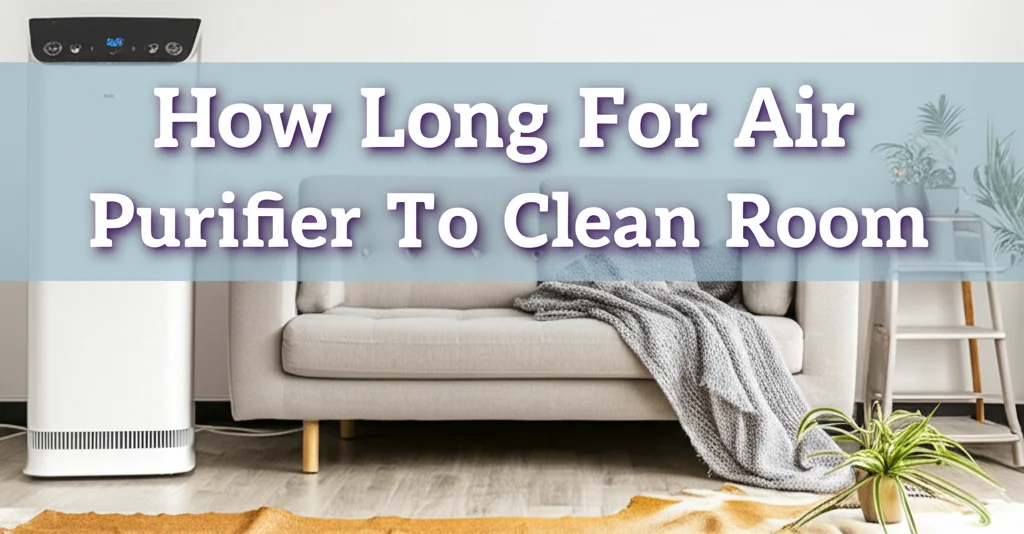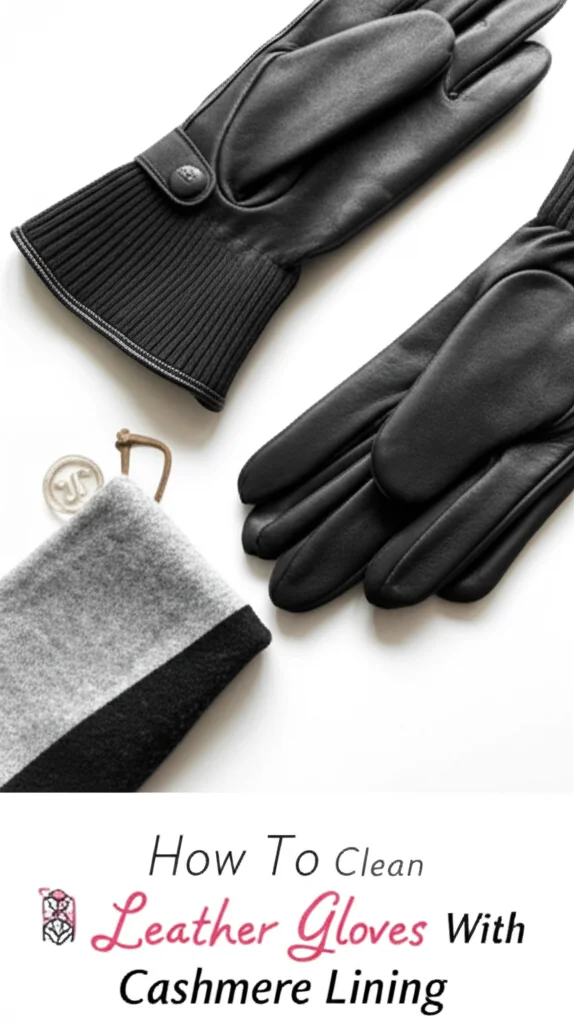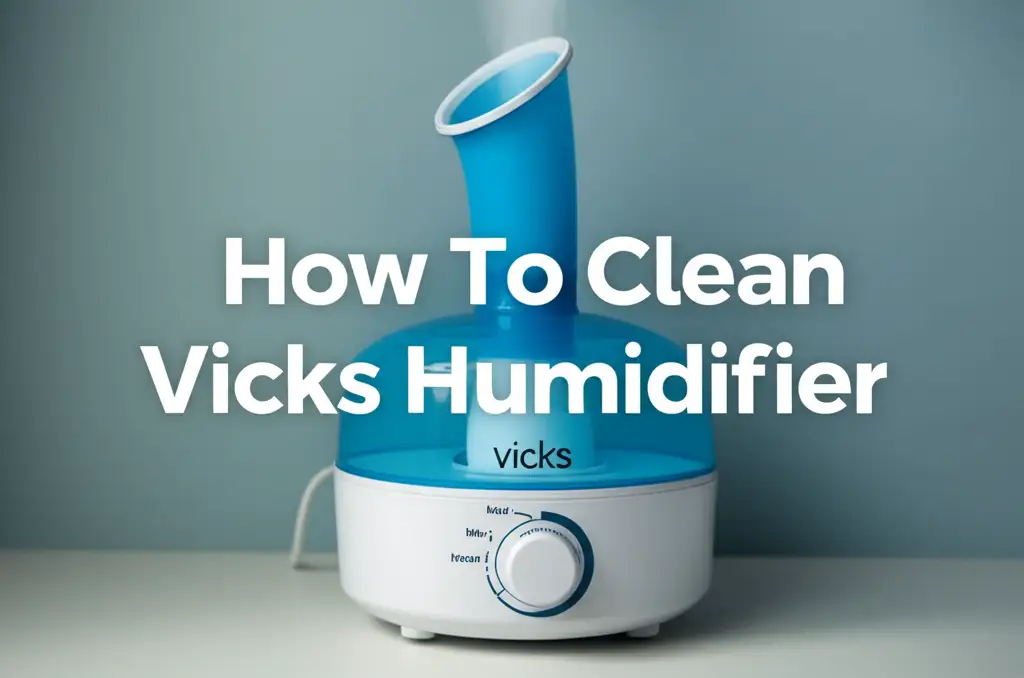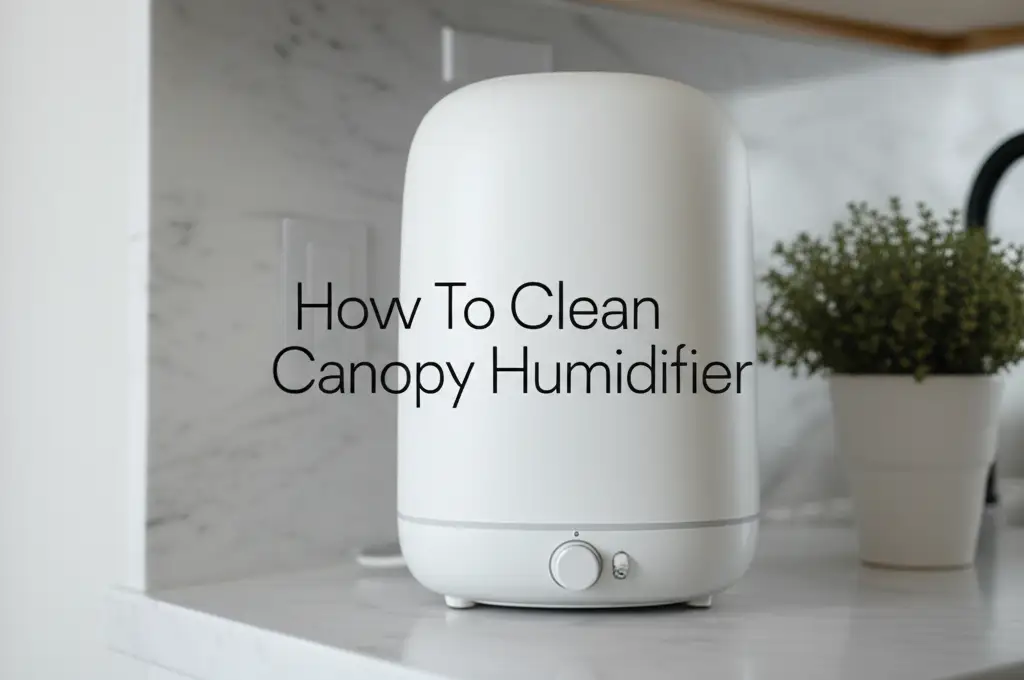· Home & Living · 12 min read
How Long For Air Purifier To Clean Room

How Long For Air Purifier To Clean Room: Complete Guide To Maximum Efficiency
Quick Takeaway:
- Most air purifiers clean a room in 30 minutes to 2 hours, depending on room size and purifier capacity
- CADR (Clean Air Delivery Rate) is the key metric for determining cleaning speed
- For optimal cleaning, match your purifier’s capacity to your room size
- Running your air purifier continuously provides the best air quality results
In a nutshell: An average air purifier will clean a standard-sized room (about 300 sq ft) in approximately 1-2 hours when operated at maximum speed. However, the exact timeframe depends on your room size, air purifier capacity, airflow settings, and the specific pollutants present.
Understanding Air Purifier Cleaning Time Factors
When you bring home a new air purifier, the burning question is usually: “How long until I can breathe cleaner air?” The truth is, multiple factors affect how quickly your air purifier can clean your room. Understanding these variables helps set realistic expectations and ensures you’re getting the most from your investment.
The speed at which an air purifier cleans a room depends primarily on four factors: the size of your room, the purifier’s Clean Air Delivery Rate (CADR), the type and concentration of pollutants present, and your chosen fan speed setting. For example, a high-CADR purifier in a small room might complete a full air change in just 15-20 minutes, while the same unit in a larger space could take an hour or more.
Most manufacturers design their air purifiers to perform 4-5 complete air exchanges per hour in a room of the recommended size. This means your air purifier should filter all the air in your room every 12-15 minutes under ideal conditions. However, real-world performance often varies due to room layout, furniture placement, and ongoing introduction of new pollutants.
It’s also worth noting that different pollutants require different filtering technologies and removal times. While larger particles like dust and pet dander may be captured quickly, smaller particulates, VOCs, and odors might take longer to eliminate completely.
The Science Behind Air Purifier Efficiency: CADR Explained
The most scientific way to determine how long an air purifier will take to clean your room is by looking at its Clean Air Delivery Rate (CADR). This standardized measurement, typically expressed in cubic feet per minute (CFM), tells you how much filtered air the purifier delivers.
CADR ratings are usually provided for three common pollutants:
- Dust (larger particles)
- Tobacco smoke (medium-sized particles)
- Pollen (larger allergen particles)
A higher CADR number indicates faster cleaning capability. For example, an air purifier with a CADR of 300 will clean a room much faster than one with a CADR of 100. As a general rule, you want a CADR that’s at least two-thirds of your room’s square footage. So for a 300 square foot room, look for a CADR of at least 200.
To calculate approximate cleaning time, you can use this formula:
Time (in minutes) = (Room volume in cubic feet × Number of air changes) ÷ CADRFor instance, if your room is 12ft × 15ft with 8ft ceilings (1,440 cubic feet) and your purifier has a CADR of 300, one complete air change would take about 4.8 minutes (1,440 ÷ 300). For five complete air changes—which is generally considered thorough cleaning—you’d need about 24 minutes.
However, it’s important to understand that air purification isn’t an all-or-nothing process. Your air starts becoming cleaner as soon as the purifier begins operating, with noticeable improvements often felt within the first 30 minutes.
Room Size and Air Purifier Matching: Finding the Perfect Fit
One of the most common mistakes people make is using an air purifier that’s too small for their space. When your purifier is underpowered for your room size, it will take significantly longer to clean the air—if it can effectively clean it at all.
Most air purifier manufacturers list a maximum recommended room size for each model. This figure is usually based on performing 4-5 complete air changes per hour. Here’s a general guideline for matching room size to air purifier capacity:
- Small rooms (up to 200 sq ft): CADR of 130 or higher
- Medium rooms (200-400 sq ft): CADR of 130-350
- Large rooms (400-600 sq ft): CADR of 350+
Remember that these are minimum recommendations. For faster cleaning or heavily polluted environments, choose a purifier with higher CADR ratings than the minimum suggested for your space.
Room shape and ceiling height also affect cleaning time. Open floor plans allow for better air circulation compared to rooms with multiple partitions or alcoves. Similarly, rooms with high ceilings contain more air volume to filter, potentially extending the cleaning time. If your room has ceilings higher than 8 feet, you’ll need to account for the additional volume when selecting your purifier.
For optimal performance, place your air purifier where it has room to pull in air from all sides (if it’s designed for 360° intake) and away from obstacles that could block airflow. Central locations often work best, though specific placement might depend on your main concerns—like near windows for pollen or near the kitchen for cooking odors.
Real-World Timeline: From Startup to Clean Air
When you first turn on your air purifier in a polluted room, you might wonder exactly when you’ll notice improvements. Here’s a general timeline of what to expect:
First 30 minutes: During this initial phase, larger particles like dust, pet hair, and visible pollutants begin to be filtered out. If you’re using a high-quality purifier at maximum speed in an appropriately sized room, you might already notice some improvement in air quality, especially if you were dealing with strong odors or high levels of visible particles.
1-2 hours: By this point, most standard-sized rooms (around 300 sq ft) should show significant improvement. Most larger allergens, dust, and many odors will be noticeably reduced. If your purifier has activated carbon filters, many VOCs and stronger odors should be diminishing as well.
4-6 hours: After several hours of continuous operation, your air purifier should have performed multiple complete air exchanges, resulting in substantially cleaner air. Most particles, including smaller ones like many bacteria and some viruses (if your purifier has HEPA filtration), will be significantly reduced.
12-24 hours: For the most thorough cleaning, especially in larger spaces or heavily polluted environments, running your air purifier for a full day can ensure that even the most persistent pollutants are addressed. This is particularly important for addressing deeply embedded odors or allergens that might be continuously released from furnishings.
It’s worth noting that while many users report feeling better or breathing easier within hours of using an air purifier, scientific measurements might show continued improvements in air quality over longer periods. Some users report taking a few days to notice the full benefits, especially for allergy symptoms or when dealing with very fine particulate matter that may have settled throughout the room.
Optimizing Air Purifier Run Time for Different Scenarios
Different situations call for different approaches to running your air purifier. Here’s how to optimize run times for common scenarios:
For Allergies and Asthma
If you’re managing respiratory conditions, continuous operation is generally best. Allergens constantly enter living spaces, even in seemingly clean environments. Running your purifier 24/7 on at least a medium setting provides consistent protection. During high pollen seasons or when symptoms flare, increase to maximum speed for several hours.
For Odor Elimination
Cooking odors, pet smells, or other temporary odors require different treatment than ongoing air quality management. For sudden odors:
- Run your purifier on high speed immediately when odors appear
- Continue operation for 1-2 hours after cooking or other odor-producing activities
- Place the purifier closer to the odor source temporarily for faster results
Carbon filters are especially effective for removing household odors, but they can become saturated over time. If your air purifier doesn’t seem to be eliminating odors as efficiently, it might be time to replace the carbon filter.
For Smoke and VOC Removal
Smoke particles and volatile organic compounds (VOCs) present special challenges due to their small size and persistence. Whether dealing with wildfire smoke, cooking smoke, or VOCs from new furniture:
- Run your purifier on maximum speed for at least 2-3 hours
- Continue operation at medium-high speed for 24-48 hours
- Consider using multiple purifiers for faster results in larger spaces
Remember that some pollutants, particularly certain VOCs and very fine smoke particles, may take longer to completely remove and might require specialized filters beyond standard HEPA.
For Sleep Environments
Bedrooms present unique considerations since you’ll be spending 7-9 hours there daily:
- Run the purifier on high for 1-2 hours before bedtime to thoroughly clean the room
- Reduce to low or sleep mode overnight to maintain air quality while minimizing noise
- Place the purifier at least 3 feet from your bed for optimal airflow without direct drafts
Many modern air purifiers include sleep modes that reduce fan speed and dim lights automatically, making them perfect for overnight operation.
Common Questions About Air Purifier Operation Time
How long does an air purifier take to purify a room?
An appropriately sized air purifier typically takes 30 minutes to 2 hours to significantly clean the air in a room, depending on the room size and purifier’s CADR rating. For complete cleaning of all airborne particles, allow 4-6 hours of continuous operation.
How long does it take to clear air in a room?
With windows closed and an appropriately sized air purifier running at maximum speed, most rooms show noticeable air quality improvement within 30-60 minutes. Complete air clearing typically takes 2-4 hours for standard pollutants. Some persistent odors or VOCs may require 12-24 hours for complete elimination.
How do you know if an air purifier is working?
Signs your air purifier is working include: reduced dust accumulation on surfaces, diminished odors, easier breathing, reduced allergy symptoms, and less visible particles in sunlight beams. Many modern air purifiers also include air quality sensors that display real-time pollution levels, showing improvements as the device operates.
Does an air purifier keep a room clean?
An air purifier effectively removes airborne particles and many odors, but doesn’t replace regular cleaning for surfaces, floors, or deep cleaning needs. For comprehensive home cleanliness, combine air purification with regular dusting, vacuuming with HEPA filtration, and appropriate surface cleaning.
Can I run air purifier 24 hours?
Yes, most air purifiers are designed for continuous operation, and running them 24/7 provides the best ongoing air quality. Modern energy-efficient models consume relatively little electricity, especially when operating on lower speeds after initial cleaning. Many users find the greatest benefits when air purifiers run continuously, preventing pollutant buildup.
Why is my room still dusty even with an air purifier?
If your room remains dusty despite using an air purifier, consider: your purifier may be undersized for the space, filters might need replacement, dust could be continuously generated from sources like textiles or pets, external doors/windows might frequently introduce new particles, or the dust may be settling on surfaces faster than the purifier can capture airborne particles. Regular cleaning of hard surfaces remains necessary even with air purification.
Maintaining Your Air Purifier for Optimal Cleaning Speed
To ensure your air purifier continues cleaning your room efficiently over time, proper maintenance is essential. As filters become clogged with captured particles, air flow decreases and with it, cleaning effectiveness. Here’s how to keep your air purifier performing at its best:
Filter Replacement Schedule
Most HEPA filters need replacement every 6-12 months, depending on usage and air quality. Carbon filters typically last 3-6 months before becoming saturated. Some units feature washable pre-filters that should be cleaned monthly. Always follow manufacturer recommendations, but consider more frequent replacements if you have pets, live in a high-pollution area, or run your purifier continuously.
Regular Cleaning
Dust the exterior of your purifier weekly to prevent redistribution of collected particles. Check air intake and output vents monthly, gently vacuuming any visible dust accumulation that might restrict airflow. For washable pre-filters, rinse thoroughly and ensure complete drying before reinstallation to prevent mold growth.
Placement Optimization
Periodically reassess your purifier’s placement. As seasons change or room arrangements shift, the optimal location might change. Keep the unit at least 1-2 feet away from walls and furniture, and ensure it’s not blocked by curtains, plants, or other obstacles that could restrict airflow and reduce cleaning efficiency.
Addressing Decreased Performance
If your air purifier seems to be taking longer to clean your room than when first purchased, first check filter condition—even before the recommended replacement time. Also inspect for any obstructions in airflow pathways and confirm the fan is operating at full capacity on higher settings. Some units develop dust on internal components that can affect performance and may benefit from professional cleaning.
Final Thoughts: Balancing Expectations and Results
Understanding how long it takes for an air purifier to clean your room helps set realistic expectations and maximize the benefits of your investment. While many factors influence cleaning time, most quality air purifiers will significantly improve air quality within 1-2 hours and achieve optimal results within 4-6 hours in appropriately sized spaces.
For the best ongoing air quality, consider running your purifier continuously on lower settings rather than intermittently at high speeds. This approach maintains consistently clean air while conserving energy and extending filter life. Remember that an air purifier works best as part of a comprehensive approach to indoor air quality that includes regular home cleaning, source control of pollutants, and adequate ventilation when outdoor air quality permits.
By selecting the right air purifier for your space, understanding its capabilities and limitations, and maintaining it properly, you’ll enjoy cleaner, fresher air and the many health benefits that come with improved indoor air quality. While instant results shouldn’t be expected, the progressive improvement in air quality that occurs over the first few hours of operation makes an air purifier one of the most effective tools for creating a healthier indoor environment.
- air purifier
- room size
- air quality
- CADR




